| Suite
Gothique by David M Patrick
Buy this album now CD: £12.99 + p&p |
| Suite Gothique - Leon Boëllmann (1862-1897) | ||
| 01 | Introduction - Chorale | 2:22 |
| 02 | Menuet
Gothique |
2:37 |
| 03 | Prière à Notre-Dame | 4:54 |
| 04 | Toccata | 3:30 |
| Sonata No.7 in F Op.89 - Alexander Guilmant (1837-1911) | ||
| 05 | Entrée | 6:27 |
| 06 | Lento assai | 3:35 |
| 07 | Intermezzo | 5:26 |
| 08 | Grand Choeur (Tempo di minuetto) | 2:56 |
| 09 | Cantabile | 6:02 |
| 10 | Final | 5:11 |
| Dix Pièces pour orgue - Eugène Gigout (1844-1925) | ||
| 11 | Minuetto | 4:38 |
| 12 | Toccata | 2:50 |
| 13 | Grande Pièce Symphonique Op.17 - Cèsar Franck (1822-1890) | 24:59 |
| Total playing time 76:30 | ||
SUITE GOTHIQUE Léon Boëllmann (1862-97)
Best known today for his Suite Gothique composed in 1895, Léon Boëllmann's highly promising career was terminated by his untimely death. A pupil of Eugène Gigout at the École Niedermeyer, he became organist at Saint-Vincent-de-Paul in Paris in 1896. Other published works include some fine chamber music, Symphonic Variations for cello and orchestra, a Symphony in F, and the Deuxième Suite for organ.
Introduction – Chorale (C minor). Composed in an archaic neo-modal style, the opening phrase cadences on the dominant minor chord (G minor) and the second phrase on the mediant (E flat major). Throughout, the music alternates between fff and p sections, concluding quietly with a conventional imperfect cadence on the dominant (G major).
Menuet Gothique (C major). This movement is a curious mixture of ecclesiastical austerity and 18th century elegance. It opens with a minuet in C major which becomes increasingly modal in feeling through the use of flattened sevenths in the harmonies. The contrasting middle section, beginning in C major with a sprightly rising broken chord idea, is developed through a variety of new keys and features some brief returns of the initial minuet. A reprise of the first section rounds the movement off in commanding style.
Prière à Notre Dame (A flat major). A devout atmosphere is set by a recurring sinuous melody played on a flute stop. Three answering sections are based on a strikingly romantic harmonic progression, consisting of the unrelated chords of D flat and E major (or vice-versa).
Toccata (C minor). The formula of brilliant manual figuration above a broad theme in the pedals is derived from Widor's famous example. In this case, the slightly macabre theme rises in dotted rhythms from the tonic to the flattened dominant notes of the scale, twisting the music into the flattened supertonic key of D flat major for a couple of bars. By contrast, a rhythmically syncopated melody emerges in the right hand part, accompanies by the semitone motive also heard at the beginning of the movement. After further appearances of these themes in different keys and with increasing intensity, the coda brings back the opening theme played fff in double pedal octaves.
SONATA NO. 7 IN F MAJOR OP. 89 Alexandre Guilmant (1837-1911)
Alexandre Guilmant studied with Lemmens in Brussels, and became organist of both the Église de la Trinité and the Trocadéro Palace in Paris. One of the outstanding players of his time, his scope and energy in the service of his instrument was immense, as an international recitalist, teacher, prolific composer and reviver of early music.
Entrée (F major). Like a vast Handelian aria in its general form and style, its tonal expanse nevertheless ranges far beyond 18th century practice. The middle section, in D minor, at first continues the previous heavy neo-baroque texture of chains of thirds and sixths. However, a new theme in B flat major, in popular march style with chromatic passing notes, adds a strikingly eclectic element, characteristic of the age.
Lento Assai (A major). A dream-like atmosphere is created by an impressionistic stream of dominant seventh chords astonishing in this context, and reflecting Guilmant's broad-minded interest in Debussy. This gives way to a contrasting modal style theme and harmonisation.
Intermezzo (D minor). In this Schumannesque movement, a flow of tonally restless poetic melody is propelled by pianistic style broken chords cunningly adapted to the organ. More homophonic type sections in F and B flat provide an effective contrast.
Grand Choeur ( D major). This robust fugal style movement successfully avoids thickness and heaviness of texture by means of frequent rests in the part writing and economy of pedal entries. A final tightening of grip is achieved with a closely dovetailed three-part stretto.
Cantabile (F major). A naïve folk-style melody recurs throughout, over drone-like pedal-points in fifths. The contrasting middle section consists of streams of murmuring chords played on voix célestes.
Final (F minor). This sonata form movement commences with a virile theme characterised by a leap of a tenth, followed by triplet quavers. Heralded by a powerful series of syncopated chords, the second subject, in A flat major, is a lyrical melody which plays a leading part in the ensuing development section, appearing over pedal points in the keys of E and C major. The textures of the recapitulation section are heavily reinforced.
DIX PIÈCES POUR ORGUE (selection) Eugène Gigout (1844-1925)
Eugène Gigout studied with Loret at the École Niedermeyer in Paris, where Fauré was his fellow student. Organist of Saint-Augustin, he succeeded Guilmant as organ professor at the Paris Conservatoire.
Minuetto (B major). The gently undulating oboe theme reveals an unusual phrase structure, initially of six bars, gradually reducing in length; this is answered by elegant chains of thirds in the left hand part. A contrasting melody, of a rising contour leads to a middle section in G major, based on a wider ranging arpeggio type idea.
Toccata (B minor). If this is Gigout's more modest answer to his rival Widor's brilliant Toccata, the result is nonetheless highly effective and telling in its economical use of fewer notes. Against broken chord figuration neatly divided between the hands, the pedal enters with a rising octave idea, like a horncall. Gradually, a more broad and continuous line takes shape in the bass, characterised by oscillating thirds. Eventually this is evened out into mainly stepwise movement, below semiquaver figuration in the right hand and staccato repeated chords in the left – a similar texture to Widor's. The movement ends with a brief harmonic fanfare.
GRAND PIÈCE SYMPHONIQUE OP. 17 César Franck (1822-90)
The unglamorous Belgian-born César Franck worked in relative obscurity for most of his life as organist of Sainte-Clotilde and organ professor at the Paris Conservatoire. Only in his final decade did he realise his full potential and produce his most valuable compositions, including the Symphony in D minor and the Trois Chorals for organ. The Grand Pièce's weighty slow introduction à la Beethoven and the Lisztian cyclic theme resembling that of the Symphony in D Minor, appearing first in the opening movement and later in the finale.
Andantino Serioso (introduction in F sharp minor). A sombre idea in quaver movement, accompanied by throbbing syncopated chords, gropes its way towards the first movement proper, throwing up some expressive ideas en passant.
Allegro non troppo e maestoso (F sharp minor). In this sonata form structure, the gaunt cyclical theme is stated as the first subject, first exposed in the pedals alone. In its subsequent extended treatment it acquires a flowing countermelody before turning into a brisk march. Passages of canonic imitation, very typical of Franck's general style, lead to the second subject, a broad serene chorale in A major. The cyclic theme reappears as the basis of the central development section, accompanied by toccata-like triplet quaver figuration. This flows uninterrupted into the recapitulation, where the second subject chorale receives intensification by close canonic imitation in the pedal line.
Andante-Allegro-Andante (B major - B minor - B major). In the Lisztian manner, the slow movement and scherzo are "telescoped" into one. The Andante sections consist of a sublime lyrical melody, richly harmonised; its answering phrases again show Franck's flair for canonic writing. The contrasting Allegro in 2/4 time exploits nimble semiquaver writing, with broken chords frequently split between the hands. A more sustained melody appears, divided between the right hand and pedals.
Allegro non troppo e maestoso. Franck adopts Beethoven's idea in the Ninth Symphony's finale of reviewing the main themes of the previous movements. But whereas Beethoven proceeds to dismiss them in order to announce the "Ode to Joy", Franck does so to reinforce the cyclic theme's return in glorious F sharp major. This is now treated more broadly and majestically, with running virtuouso quavers in the pedals. Breaking off abruptly, a fugue immediately takes over, its subject a forceful and spiritually positive transformation of the cyclic theme's initial motive. The movement ends triumphantly with brilliant fanfares.
© Andrew Thomson
DAVID M. PATRICK
David M. Patrick, who was born in Devon, England in 1947, is one of the most brilliant British organists of his generation. He pursued his musical education at the Royal College of Music with distinction, winning the Stuart Prize for organ in 1967 and the coveted Walford Davies Prize the following year. This award brought him prestigious recitals at both Westminster Abbey and Westminster Cathedral.
His early decision to specialise in romantic and modern French repertoire followed logically from his impulse to accept the highest technical and artistic challenges that the organ presents. Perceiving the unjustified neglect of its composers in the period between Franck and Messiaen, he has pioneered successfully the works of Widor, Vierne and Duruflé in his critically acclaimed commercial recordings and BBC broadcasts.
His recording of the complete organ works of Maurice Duruflé, made in Coventry Cathedral in 1996, was listed as a Critic’s Choice of the Year by BBC Music Magazine. In a letter to David M. Patrick, the late Marie Madeleine Duruflé said “Vos interprétations des œuvres de M. Duruflé sont excellentes, je vous en félicite….bien…. Très bien… brillant… BRAVO.”
At the same time David M. Patrick has been active as a “live” recitalist. In an extended tour of the United States of America and Canada, he played in Washington D.C., New York, Baltimore, New Jersey, Toronto and Kitchener. November and December 1997 saw his first broadcasts on Norwegian national radio NRK P2. Meanwhile he continues to give recitals at both home and abroad including in England, Southwell Minster, Portsmouth Cathedral and St Mary Redcliffe, Bristol and in Norway the Domkirkes of Bodø, Stavanger, Fredrikstad, Tønsberg Oslo, Kristiansand, Molde and Tromsø and in Iceland at Hallgrimskirkja, Reykjavik. In August 2000 he recorded a new CD of Widor’s 3rd and 6th Organ Symphonies. Suite Gothique is his first recording for ZERGA.
GRAND ORGUE: PEDAL: POSITIF
EXPRESSIF:
|
RECIT
EXPRESSIF: COUPLERS and accessories: Grande-Orgue
/ Pedal Tremulant
Positif Crescendo
1 |
VAN DEN HEUVEL-ORGAN |
| KATARINA CHURCH | ||
| STOCKHOLM | ||
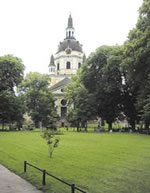 |
||
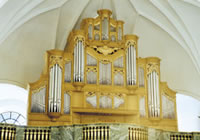 |
||
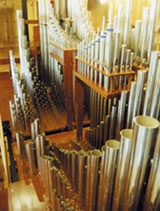 |
||
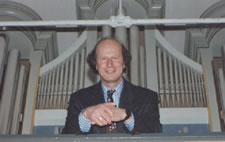 |
THE ARTWORK
Colchester-based artist Rachel Smith was specially commissioned by Zerga to provide the cover illustration for Suite Gothique. The cover art was directly inspired by listening to the music. Below are some more examples of Rachel's work. If you would like more information on the paintings, please contact ZERGA
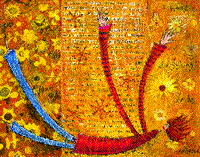 |
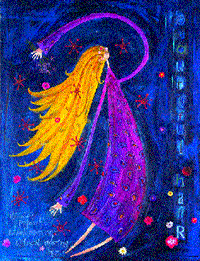 |
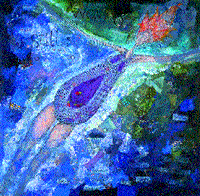 |
Creditsedits
Recorded on: 19, 20 and 21 July 2001 Executive Producer: Nicholas Dicker Recording Engineered and produced by: Paul Crichton Recorded at: Katriana Church, Stockholm Original Artwork: Rachel Smith
All rights reserved. Unauthorised copying, hiring, lending, public performance and broadcasting prohibited
| Instruments: | Organ |
| Genre: | Classical |
| Format: | CD |
| Our Ref: | A0018 |
| MCPS: | ZXS 1 |
| Label: | Zerga |
| Year: | 2001 |
| Origin: | UK |
| Please click here for Artist Information and Contact Details | |
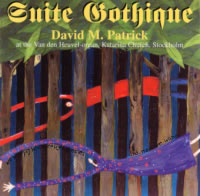 Every time I hear a recording of David
M. Patrick playing French repertoire I emerge from the experience
with my head spinning ... stunning virtuosity ... registrations
which produce brilliance of tone. THE GRAMOPHONE
Every time I hear a recording of David
M. Patrick playing French repertoire I emerge from the experience
with my head spinning ... stunning virtuosity ... registrations
which produce brilliance of tone. THE GRAMOPHONE